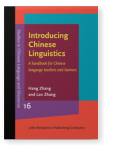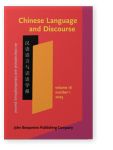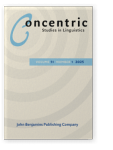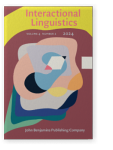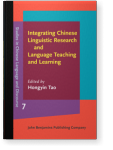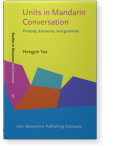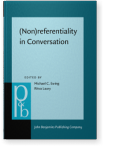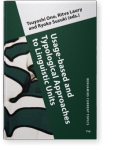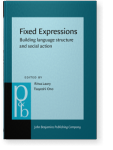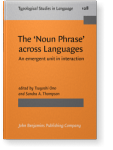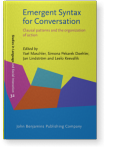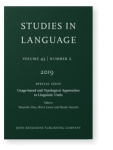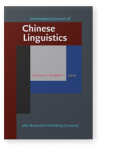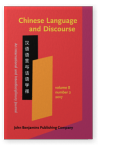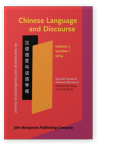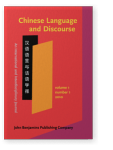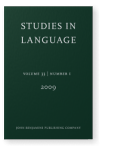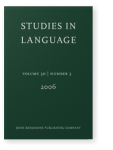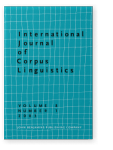Hongyin Tao
List of John Benjamins publications for which Hongyin Tao plays a role.
Book series
Journals
ISSN 1877-7031 | E-ISSN 1877-8798
ISSN 1810-7478 | E-ISSN 2589-5230
ISSN 2666-4224 | E-ISSN 2666-4232
Titles
Integrating Chinese Linguistic Research and Language Teaching and Learning
Edited by Hongyin Tao
[Studies in Chinese Language and Discourse, 7] 2016. xviii, 239 pp.
Subjects Applied linguistics | Language acquisition | Language teaching | Sino-Tibetan languages
Units in Mandarin Conversation: Prosody, discourse, and grammar
Hongyin Tao
[Studies in Discourse and Grammar, 5] 1996. xvi, 226 pp.
Subjects Discourse studies | Pragmatics | Sino-Tibetan languages | Syntax
2024 Chapter 9. An interactional approach to generic second person expressions in Mandarin conversation (Non)referentiality in Conversation, Ewing, Michael C. and Ritva Laury (eds.), pp. 167–202 | Chapter
This chapter tackles the hitherto under-explored question of when and why conversationalists deploy second person generic expressions that feature a general and vague referential scope. I show that the conversational contexts in which they appear are usually characterized most prominently by… read more
2021 Referring expressions in categorizing activities: Rethinking the nature of linguistic units for the study of interaction Usage-based and Typological Approaches to Linguistic Units, Ono, Tsuyoshi, Ritva Laury and Ryoko Suzuki (eds.), pp. 87–121 | Chapter
Linguistic units as traditionally conceived by linguists favor structural features and referential meanings. In this paper, we propose a new way of understanding the nature of linguistic units by analyzing the interaction of multiple semiotic resources (gestures, bodily movement, eye gaze and… read more
2020 Chapter 4. Formulaicity without expressed multiword units Fixed Expressions: Building language structure and social action, Laury, Ritva and Tsuyoshi Ono (eds.), pp. 71–98 | Chapter
In this chapter, I investigate three types of formulaic structure that can be characterized as underspecified with elliptical materials and lacking the kind of expressed multiword units as typically conceived. The elliptical or source structures are shown to manifest in different unit sizes: (a)… read more
2020 Chapter 11. NP clustering in Mandarin conversational interaction The ‘Noun Phrase’ across Languages: An emergent unit in interaction, Ono, Tsuyoshi and Sandra A. Thompson (eds.), pp. 271–314 | Chapter
Noun phrases (NPs) have traditionally been analyzed as a phrasal level unit with hierarchical internal structures as well as syntactic roles in larger syntactic units. In this chapter, I examine NP-related patterns at the discourse level. Using Mandarin conversation data, this chapter focuses on… read more
2020 Chapter 6. From matrix clause to turn expansion: The emergence of wo juede ‘I feel/think’ in Mandarin conversational interaction Emergent Syntax for Conversation: Clausal patterns and the organization of action, Maschler, Yael, Simona Pekarek Doehler, Jan K. Lindström and Leelo Keevallik (eds.), pp. 151–182 | Chapter
One way complex clauses manifest themselves is through a combination of a matrix clause and a complement clause. However, matrix clauses as represented by constructions such as I think have been widely reported to undergo grammaticization, whereby they become a marker indicating the speaker’s… read more
2019 Referring expressions in categorizing activities: Rethinking the nature of linguistic units for the study of interaction Usage-based and Typological Approaches to Linguistic Units, Ono, Tsuyoshi, Ritva Laury and Ryoko Suzuki (eds.), pp. 329–363 | Article
Linguistic units as traditionally conceived by linguists favor structural features and referential meanings. In this paper, we propose a new way of understanding the nature of linguistic units by analyzing the interaction of multiple semiotic resources (gestures, bodily movement, eye gaze and… read more
2019 基于语料库的“弄”字句的结构、语义和语用考察 [Structural, semantic, and pragmatic properties of nong (弄) constructions in Mandarin discourse: Evidence from corpora] International Journal of Chinese Linguistics 6:1, pp. 162–176 | Article
前人对“弄”字句已有大量著述,但我们基于若干口语和书面语语料库的考察发现,除了低度及物属性外,“弄”字句还有带补语结构和固化结构的显著特征。另外,“弄”字句整体呈现出论元结构简单、述语结构复杂的趋势。这两个趋势可以通过“弄”字句的非庄重性、负面情感意义、高度主观化等语用特征统一给出解释。在方法论上,本文试图为动词论元结构研究提供一个基于语料库的语用视角。
read more2017 A crosslinguistic study of some extended uses of what -based interrogative expressions in Chinese, English, and Korean Chinese Language and Discourse 8:2, pp. 137–173 | Article
Interrogative pronouns such as what in English, shenme in Mandarin Chinese, and mwe/mwusun in Korean all have developed extended uses beyond interrogation. Such uses may include filling a gap in conversation, softening a speaker’s epistemic stance, and indicating strong emotions such as… read more
2016 Integrating Chinese linguistic research and language teaching and learning: An introduction Integrating Chinese Linguistic Research and Language Teaching and Learning, Tao, Hongyin (ed.), pp. xiii–xviii | Article
2016 Patterns of plural NP + dou (都) expressions in conversational discourse and their pedagogical implications Integrating Chinese Linguistic Research and Language Teaching and Learning, Tao, Hongyin (ed.), pp. 169–194 | Article
As a common adverb, dou (都) ‘all, every, completely, even’ has received extensive attention from various theoretical approaches. However, most previous studies tend to focus on its semantic scope and quantification functions. In this paper, we take an interactional linguistics approach to explore… read more
2014 The rise of a high transitivity marker 到 dao in contemporary Chinese: Co-evolvement of language and society Current Trends in Chinese Discourse, Wang, Wei and Linda Tsung (eds.), pp. 25–52 | Article
Transitivity has been approached from various discourse functional points of view. In this paper, we describe the emergence in standard Chinese of a marker of high transitivity, 到 dao ‘reach’, in syntactic contexts where it has not been attested before (e.g., 帮助到你 bangzhu
dao
ni ‘help you’). read more
2010 Conversation, grammar, and fixedness: Adjectives in Mandarin revisited Chinese Language and Discourse 1:1, pp. 3–30 | Article
The categoriality of ‘adjectives’ has been a favorite topic of discussion in functional Chinese linguistics. However, the literature leaves us with no clear picture of the ‘adjective’ category for Mandarin. In this paper, we take a usage-based approach to revisit the issue of adjectives in Mandarin. read more
2009 A unified account of causal clause sequences in Mandarin Chinese and its implications Studies in Language 33:1, pp. 69–102 | Article
Causal clauses introduced by yīnwèi in Chinese can have either an initial position or a final position with regard to the main clause. While traditional grammars have treated the initial sequence as the default form, numerous discourse-based studies have shown just the opposite. However, few have… read more
2006 Richard Xiao & Tony McEnery 2004, Aspect In Mandarin Chinese: A Corpus-based Study Studies in Language 30:3, pp. 626–632 | Miscellaneous
2003 A usage-based approach to argument structure: ‘Remember’ and ‘Forget’ in spoken English International Journal of Corpus Linguistics 8:1, pp. 75–95 | Article
The English verbs remember and forget are typically treated by syntacticians as mental process verbs whose argument structure is characterized by a variety of possible complements. Based on extensive corpus data, Tao (2001) investigates the use of remember in spoken English and proposes that… read more
